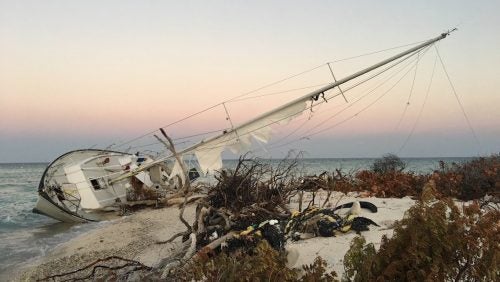Maybe the Plight of the Gulf Isn’t So Bleak: Significant Growth of Mangrove Forests in the Wake of Hurricanes Wilma and Irma
March 6, 2020 by Samuel Harris

As the Gulf Coast faces the prospect of increasingly intense hurricane seasons, a recently published paper may provide a ray of hope to local communities that already feel the effects of climate change.
By Samuel Harris, Managing Editor
Adaptation is an unrelenting principle in the natural world. Even as oceans warm and rise due to unnatural, man-made causes, our ecosystems respond through the natural methods they have used for millennia. North Atlantic storm systems have been visibly impacted by climate change, and the scientific community is just beginning to understand how delicate coastal biomes, like mangrove forests, are responding to these climatic events.
Mangrove forests are an ecosystem that remains unknown to many in the western world. Although more prevalent in the South Pacific,[1] scientists are becoming increasingly interested in the mangroves that boarder the Gulf Coast. The largest concentrations of these mangrove forests surround the southern wetlands of Florida, which boasts over 469,000 acres.[2] However, with the rise in global temperatures, species of mangroves have begun taking root in salt marshes all along the Gulf Coast.[3] Mangroves thrive in warmer brackish waters, and as the northern gulf latitudes have warmed and winters have become more mild, mangroves are beginning to dominate areas that have historically been coastal grassy marshes in Louisiana and Texas.[4]
Since the 1980s, when we first began to track storm systems using satellite, the magnitude and frequency of tropical storms and hurricanes have increased, forcing coastal environments along the Gulf of Mexico and the American East Coast to adapt.[5] New studies have emerged detailing mangroves’ response to the increase in frequency and strength of hurricanes. A paper recently published in Proceedings of the Natural Academy of Sciences found that increases in hurricane volatility has actually assisted mangrove forests withstand sea level rise and has provided ecosystems with the vital nutrients needed for rehabilitation following particularly impactful storms.[6]
The impacted mangrove forests have historically been considered delicate because of humans’ devastating impact, but they have shown remarkable resilience in the face of increasingly powerful natural storms. The paper specifically considered the impact of Hurricanes Wilma—a category 3 hurricane that made landfall in 2005—and Irma—a category 3 hurricane that made landfall in Florida in 2017.[7] The increase in ferocity of storms has brought with it significant silt deposits in the estuaries these trees populate, resulting in up to two inches of added coastal elevation in parts of the Florida Everglades.[8] Scientists view this as a benefit to the species involved, as rising sea levels otherwise threaten to drown these aquatic trees by constant immersion of their root systems.[9] Additionally, mangroves are highly dependent on high-phosphorous concentrations in the brackish coastal waters and soils where they thrive. The paper found that phosphorous levels in Florida’s estuaries experience a spike in concentration following a major storm system, either from land-based runoff or water churned up from the depths.[10] The authors discovered corresponding increases in mangrove productivity during this time, as measured by litter foliar. [11]
This is highly significant, since mangroves are considered a keystone species in many of Florida’s coastal regions and help to increase biodiversity in fragile coastal ecosystems.[12] Mangroves serve a function similar to aquatic reefs and provide a home and brooding ground to countless fish and shellfish species. In addition to huge potential increases in biodiversity, mangrove forests provide other tangible community-related benefits. Mangrove forests are incredibly important for preventing wind and wave erosion,[13] and provide substantial protection to inland communities from the same storms that seem to nurture them. By some estimates, “mangroves could be 2–6 times less expensive than the commonly used alternative [like] submerged breakwaters,” at preventing coastal flooding.[14] This could provide a natural weapon in the arsenal of coastal communities struggling to adapt.
Although this paper limited its observations to the impact on mangroves in Florida, mangrove species are widely dispersed at tropical latitudes around the globe. It is unclear at this time if areas in the Pacific exhibit similar mangrove growth, as the past two decades have witnessed an unprecedented level of Pacific category 5 storms with devastating impacts. However, as coastal communities come to terms with the threats posed by rising and warming oceans, investments in mangroves or other biological coastal defenses could provide a natural and sustainable path to human adaptation.
[1] J. Honculada-Primavera, Mangroves of Southeast Asia, SEAFDEC Aquaculture Department 1–12, 2 (2000), https://www.oceandocs.org/bitstream/handle/1834/9105/primavera2000-mangroves-of-southeast-asia.pdf?sequence=1&isAllowed=y.
[2] Florida’s Mangroves, Florida Department of Environmental Protection, https://floridadep.gov/rcp/rcp/content/floridas-mangroves (last visited Mar. 3, 2020).
[3] Mangroves in Texas, University of Houston, https://uh.edu/mangrove/research.html.
[4] Id.
[5] Hurricanes, National Climate Assessment, U.S. Global Change Research Program (2014), https://nca2014.globalchange.gov/highlights/report-findings/extreme-weather.
[6] Edward Castañeda-Moya et al., Hurricanes fertilize mangrove forests in the Gulf of Mexico (Florida Everglades, USA), 117 (9) Proc. Nat’l Acad. of Sci. 4831–41, 4831 (2020).
[7] Id. at 4832.
[8] Paul Brinkmann, Hurricanes benefit mangroves in Florida’s Everglades, study finds, United Press International (Feb. 18, 2020, 3:45 PM), https://www.upi.com/Science_News/2020/02/18/Hurricanes-benefit-mangroves-in-Floridas-Everglades-study-finds/6031582053445/.
[9] Kate Baggaley, Hurricanes lay waste to mangroves, but they also help them flourish, Popular Science (Feb. 19, 2020), https://www.popsci.com/story/environment/hurricanes-climate-change-mangrove-forests/.
[10] Supra note 5 at 1.
[11] Id.
[12] Id. at 2.
[13] U.S. Fish and Wildlife Services, Mangroves, Multi-Species Recovery Plan for South Florida 3-519–3-552, 3-522 (May 3, 2019), https://www.fws.gov/verobeach/MSRPPDFs/Mangroves.pdf.
[14] Brian Blankespoor et al., Mangroves as a protection from storm surges in a changing climate, 46(4) Ambio 478–491, 479 (Oct. 27, 2016), https://www.ncbi.nlm.nih.gov/pmc/articles/PMC5385662/.

